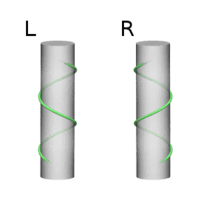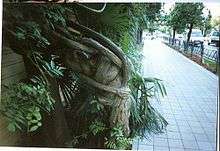Vine
A vine (Latin vīnea "grapevine", "vineyard", from vīnum "wine") is any plant with a growth habit of trailing or scandent (that is, climbing) stems, lianas or runners. The word vine can also refer to such stems or runners themselves, for instance, when used in wicker work.[1][2]
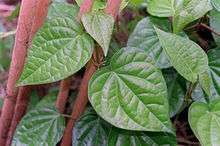
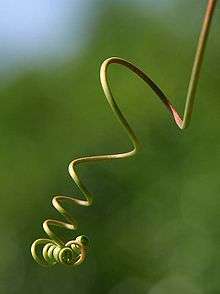
In parts of the world, including the British Isles, the term "vine" usually applies exclusively to grapevines (Vitis),[3] while the term "climber" is used for all climbing plants.[4]
Growth forms
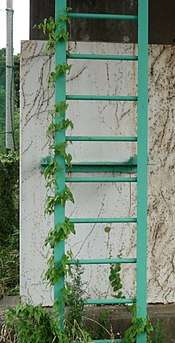
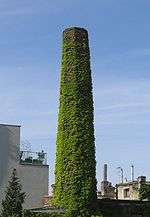
Certain plants always grow as vines, while a few grow as vines only part of the time. For instance, poison ivy and bittersweet can grow as low shrubs when support is not available, but will become vines when support is available.[5]
A vine displays a growth form based on long stems. This has two purposes. A vine may use rock exposures, other plants, or other supports for growth rather than investing energy in a lot of supportive tissue, enabling the plant to reach sunlight with a minimum investment of energy. This has been a highly successful growth form for plants such as kudzu and Japanese honeysuckle, both of which are invasive exotics in parts of North America. There are some tropical vines that develop skototropism, and grow away from the light, a type of negative phototropism. Growth away from light allows the vine to reach a tree trunk, which it can then climb to brighter regions.[6]
The vine growth form may also enable plants to colonize large areas quickly, even without climbing high. This is the case with periwinkle and ground ivy. It is also an adaptation to life in areas where small patches of fertile soil are adjacent to exposed areas with more sunlight but little or no soil. A vine can root in the soil but have most of its leaves in the brighter, exposed area, getting the best of both environments.
The evolution of a climbing habit has been implicated as a key innovation associated with the evolutionary success and diversification of a number of taxonomic groups of plants.[7] It has evolved independently in several plant families, using many different climbing methods,[8] such as:
- twining the stem around a support (e.g., morning glories, Ipomoea species)
- by way of adventitious, clinging roots (e.g., ivy, Hedera species)
- with twining petioles (e.g., Clematis species)
- using tendrils, which can be specialized shoots (Vitaceae), leaves (Bignoniaceae), or even inflorescences (Passiflora)
- using tendrils which also produce adhesive pads at the end that attach themselves quite strongly to the support (Parthenocissus)
- using thorns (e.g. climbing rose) or other hooked structures, such as hooked branches (e.g. Artabotrys hexapetalus)
The climbing fetterbush (Pieris phillyreifolia) is a woody shrub-vine which climbs without clinging roots, tendrils, or thorns. It directs its stem into a crevice in the bark of fibrous barked trees (such as bald cypress) where the stem adopts a flattened profile and grows up the tree underneath the host tree's outer bark. The fetterbush then sends out branches that emerge near the top of the tree.[9]
Most vines are flowering plants. These may be divided into woody vines or lianas, such as wisteria, kiwifruit, and common ivy, and herbaceous (nonwoody) vines, such as morning glory.
One odd group of vining plants is the fern genus Lygodium, called climbing ferns.[10] The stem does not climb, but rather the fronds (leaves) do. The fronds unroll from the tip, and theoretically never stop growing; they can form thickets as they unroll over other plants, rockfaces, and fences.
Twining vines
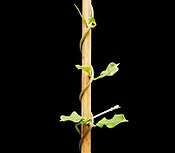
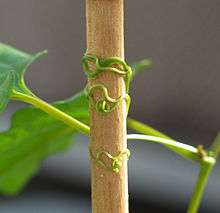
A twining vine, also known as a bine, is one that climbs by its shoots growing in a helix, in contrast to vines that climb using tendrils or suckers. Many bines have rough stems or downward-pointing bristles to aid their grip. Hops (used in flavoring beer) are a commercially important example of a bine.[13][14]
The direction of rotation of the shoot tip during climbing is autonomous and does not (as sometimes imagined) derive from the shoot's following the sun around the sky – the direction of twist does not therefore depend upon which side of the equator the plant is growing on. This is shown by the fact that some bines always twine clockwise, including runner bean (Phaseolus coccineus) and bindweed (Convolvulus species), while others twine anticlockwise, including French bean (Phaseolus vulgaris) and climbing honeysuckles (Lonicera species). The contrasting rotations of bindweed and honeysuckle was the theme of the satirical song "Misalliance",[15] written and sung by Michael Flanders and Donald Swann.
Horticultural climbing plants
The term "vine" also applies to cucurbitaceae like cucumbers where botanists refer to creeping vines; in commercial agriculture the natural tendency of coiling tendrils to attach themselves to pre-existing structures or espaliers is optimized by the installation of trellis netting.
Gardeners can use the tendency of climbing plants to grow quickly. If a plant display is wanted quickly, a climber can achieve this. Climbers can be trained over walls, pergolas, fences, etc. Climbers can be grown over other plants to provide additional attraction. Artificial support can also be provided. Some climbers climb by themselves; others need work, such as tying them in and training them.
Scientific description
Vines widely differ in size, form and evolutionary origin. Darwin classified climbing groups based on their climbing method. He classified five classes of vines – twining plants, leaf climbers, tendril bearers, root climbers and hook climbers.
Vines are unique in that they have multiple evolutionary origins. They usually reside in tropical locations and have the unique ability to climb. Vines are able to grow in both deep shade and full sun due to their uniquely wide range of phenotypic plasticity. This climbing action prevents shading by neighbors and allows the vine to grow out of reach of herbivores.[16] The environment where a vine can grow successfully is determined by the climbing mechanism of a vine and how far it can spread across supports. There are many theories supporting the idea that photosynthetic responses are closely related to climbing mechanisms.
Temperate twining vines, which twist tightly around supports, are typically poorly adapted for climbing beneath closed canopies due to their smaller support diameter and shade intolerance. In contrast, tendril vines usually grow on the forest floor and onto trees until they reach the surface of the canopy, suggesting that they have greater physiological plasticity.[17] It has also been suggested that twining vines' revolving growth is mediated by changes in turgor pressure mediated by volume changes in the epidermal cells of the bending zone.[18]
Climbing vines can take on many unique characteristics in response to changes in their environments. Climbing vines can induce chemical defenses and modify their biomass allocation in response to herbivores. In particular, the twisting vine C. arvensis increases its twining in response to herbivore-associated leaf damage, which may lead to reduced future herbivory.[19] Additionally, the tendrils of perennial vine Cayratia japonica are more likely to coil around nearby plants of another species than nearby plants of the same species in natural and experimental settings. This ability, which has only been previously documented in roots, demonstrates the vine's ability to distinguish whether another plant is of the same species as itself or a different one.
In tendrilled vines, the tendrils are highly sensitive to touch and the coiling action is mediated by the hormones octadecanoids, jasmonates and indole-3-acetic acid. The touch stimulus and hormones may interact via volatile compounds or internal oscillation patterns.[20] Research has found the presence of ion translocating ATPases in the Bryonia dioica species of plants, which has implications for a possible ion mediation tendril curling mechanism. In response to a touch stimulus, vanadate sensitive K+, Mg2+ ATPase and a Ca2+ translocating ATPase rapidly increase their activity. This increases transmembrane ion fluxes that appear to be involved in the early stages of tendril coiling.[21]
Example vine taxa
_(7899774070).jpg)
- Actinidia arguta, the tara vine
- Aconitum Bulbuliferum
- Actinidia polygama, the silver vine
- Adlumia fungosa, the Allegheny vine
- Aeschynanthus radicans, the lipstick vine
- Akebia, the chocolate vine
- Ampelocissus acetosa, known as wild grape or djabaru
- Ampelopsis glandulosa var. brevipedunculata, known as wild grape or porcelain berry
- Anredera cordifolia
- Antigonon, the coral vine
- Antigonon leptopus, the confederate vine
- Aptenia cordifolia, the heart-leaved aptenia
- Berchemia scandens, the rattan vine
- Bignonia, the cross vine
- Bougainvillea, a genus of thorny ornamental vines, bushes, and trees
- Campsis, the trumpet vine
- Campsis grandiflora, the Chinese trumpet vine
- Cardiospermum halicacabum, the balloon vine
- Celastrus, the staff vine
- Ceropegia linearis, the rosary vine or sweetheart vine
- Cissus antarctica, the kangaroo vine
- Cissus hypoglauca, the water vine
- Citrullus lanatus var. lanatus, the watermelon
- Cucumis sativus, the cucumber
- Cyphostemma juttae, known as wild grape
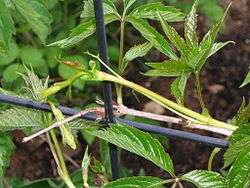
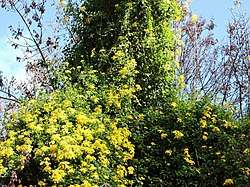
- Epipremnum aureum, known as silver vine
- Fallopia baldschuanica, the Russian vine
- Ficus pumila, known as the climbing fig
- Hedera helix, known as common ivy, English ivy, European ivy, or ivy
- Ipomoea cairica, known as Cairo morning glory, coast morning glory and railroad creeper
- Kennedia coccinea, the common coral vine
- Lagenaria siceraria, known as the bottle gourd, calabash, opo squash, or long melon
- Lathyrus odoratus, the sweet pea
- Lonicera japonica, known as Suikazura or Japanese honeysuckle
- Luffa, a genus of tropical and subtropical vines classified in the cucumber family, Cucurbitaceae
- Lygodium, a genus of about 40 species of ferns, known as climbing ferns
- Momordica charantia, the bitter gourd
- Mikania scandens, the hemp vine
- Muehlenbeckia adpressa, the macquarie vine
- Nepenthes, a genus of carnivorous plants known as tropical pitcher plants or monkey cups
- Pandorea pandorana, the wonga wonga vine
- Parthenocissus quinquefolia, known as the Virginia creeper, Victoria creeper, five-leaved ivy, or five-finger
- Passiflora edulis, the passion fruit
- Periploca graeca, the silk vine
- Podranea ricasoliana, the pink trumpet vine
- Pueraria lobata, the kudzu vine
- Scindapsus pictus, the silver vine
- Sechium edule, known as chayote, christophene, or several other names
- Senecio angulatus, known as Cape ivy
- Solandra, a genus of flowering plants in the nightshade family
- Solanum laxum, the potato vine
- Strongylodon macrobotrys, the jade vine
- Syngonium, the goosefoot vine
- Syngonium podophyllum, the arrowhead vine
- Thunbergia grandiflora, known as the Bengal clock vine or blue trumpet vine
- Thunbergia erecta, the bush clock vine
- Toxicodendron radicans, known as poison ivy
- Vitis, any of about sixty species of grape
- Wisteria, a genus of flowering plants in the pea family
See also
- Vine (disambiguation)
- Liana, any of various long-stemmed, woody vines
- Nutation (botany), bending and growth patterns of plants, which dictate the growth of vines.
- On the Movements and Habits of Climbing Plants, by Charles Darwin
- List of world's longest vines
- Vine training systems
References
- Brown, Lesley (1993). The New shorter Oxford English dictionary on historical principles. Oxford [Eng.]: Clarendon. ISBN 0-19-861271-0.
- Jackson; Benjamin; Daydon (1928). A Glossary of Botanic Terms with their Derivation and Accent, 4th ed. London: Gerald Duckworth & Co.
- Francis E. Putz (1991). The Biology of Vines. Cambridge University Press. pp. xiii. ISBN 978-0-521-39250-1.
Using 'vines' to denote all climbing plants may initially confuse some readers from lands where, with due respect for wine, 'the vine' is used solely in reference to grapes.
- Shorter Oxford English dictionary, 6th ed. Oxford, UK: Oxford University Press. 2007. p. 3804. ISBN 978-0199206872.
- "Creepers". mannuthynursery. Retrieved 17 July 2013.
- Glimn-Lacy, Janice; Kaufman, Peter B. (2006). Botany Illustrated. Springer.
- Gianoli, Ernesto (2004). "Evolution of a climbing habit promotes diversification in flowering plants". Proceedings of the Royal Society B: Biological Sciences. 271 (1552): 2011–2015. doi:10.1098/rspb.2004.2827. JSTOR 4142967. PMC 1691831. PMID 15451690.
- Putz, Francis E. "Vine Ecology". Retrieved 1 March 2012.
- Weakley, Alan (2010). Flora of the Southern and Mid-Atlantic States (PDF). p. 661.
- "Japanese climbing fern". Center for Aquatic and Invasive Plants. Retrieved 17 July 2013.
- Haldeman, Jan. "As the vine twines". Native and Naturalized Plants of the Carolinas and Georgia. Retrieved 16 January 2018.
- Weakley, Alan S. (May 2015). Flora of the Southern and Mid-Atlantic States. UNC Herbarium, North Carolina Botanical Garden, University of North Carolina at Chapel Hill. Retrieved 16 January 2018.
- bine at Merriam-Webster
- Cone Heads at Willamette Week
- Misalliance
- Gianoli, Ernesto; Molina-Montenegro, Marco A. (2005). "Leaf Damage Induces Twining in a Climbing Plant". The New Phytologist. 167 (2): 385–90. doi:10.1111/j.1469-8137.2005.01484.x. JSTOR 3694507. PMID 15998392.
- Carter, Gregory A.; Teramura, Alan H. (1988). "Vine Photosynthesis and Relationships to Climbing Mechanisms in a Forest Understory". American Journal of Botany. 75 (7): 1101. doi:10.2307/2443769. JSTOR 2443769.
- Millet, B.; Melin, D.; Badot, P.-M. (1988). "Circumnutation in Phaseolus vulgaris. I. Growth, osmotic potential and cell ultrastructure in the free moving part of the shoot". Physiologia Plantarum. 72: 133–138. doi:10.1111/j.1399-3054.1988.tb06634.x.
- Molina-Montenegro, Marco A.; Gianoli, Ernesto; Becerra, José (2007). "Interactive Effects of Leaf Damage, Light Intensity and Support Availability on Chemical Defenses and Morphology of a Twining Vine". Journal of Chemical Ecology. 33 (1): 95–103. doi:10.1007/s10886-006-9215-8.
- Fukano, Yuya; Yamawo, Akira (26 August 2015). "Self-discrimination in the tendrils of the vine is mediated by physiological connection". Proceedings of the Royal Society B: Biological Sciences. 282 (1814): 20151379. doi:10.1098/rspb.2015.1379. PMC 4571702. PMID 26311669.
- Liß, H.; Weiler, E. W. (July 1994). "Ion-translocating ATPases in tendrils of Bryonia dioica Jacq". Planta. 194 (2): 169–180. doi:10.1007/BF00196385. JSTOR 23383001.
External links
| Look up vine in Wiktionary, the free dictionary. |



